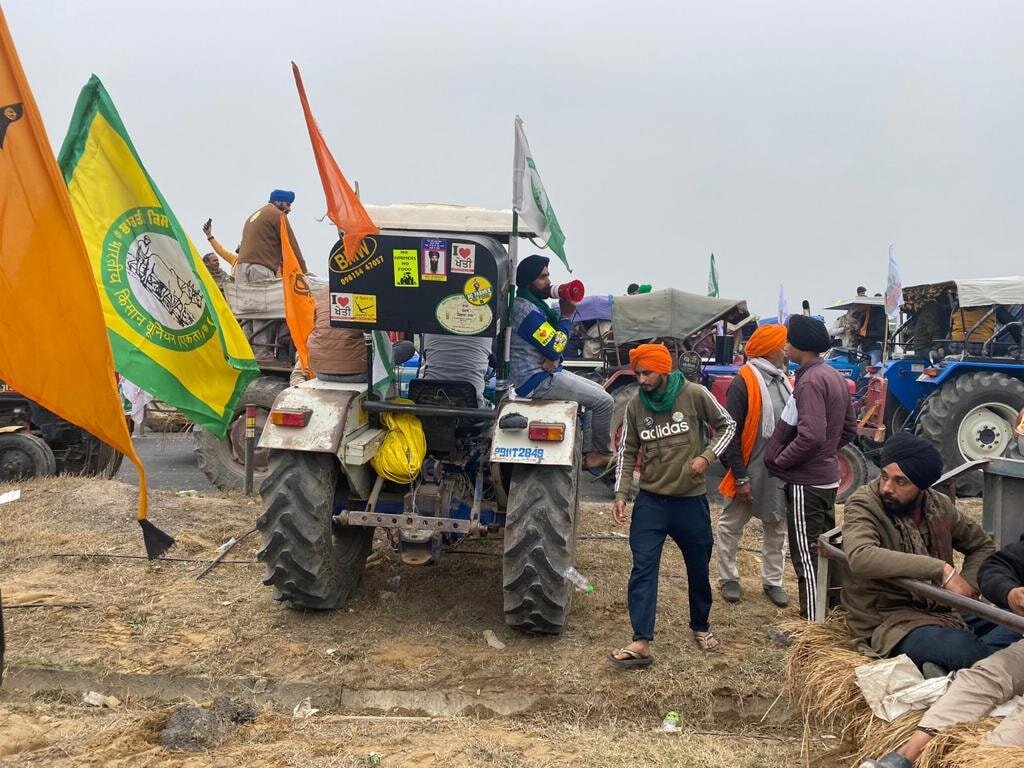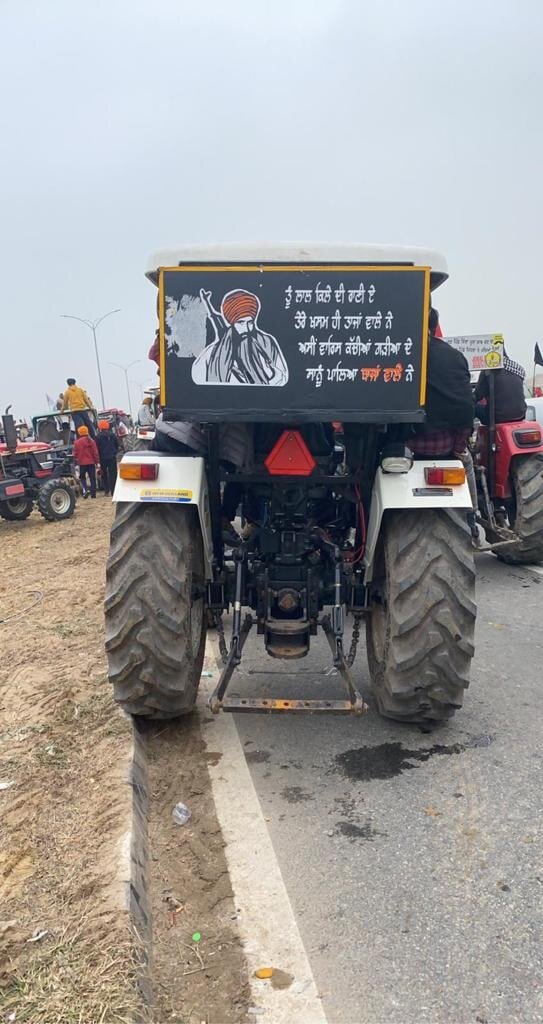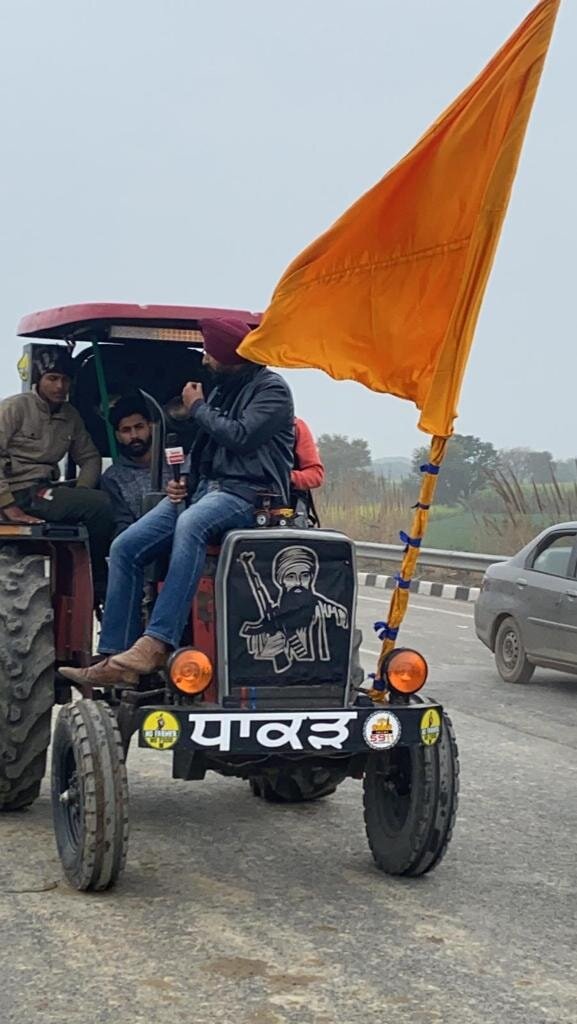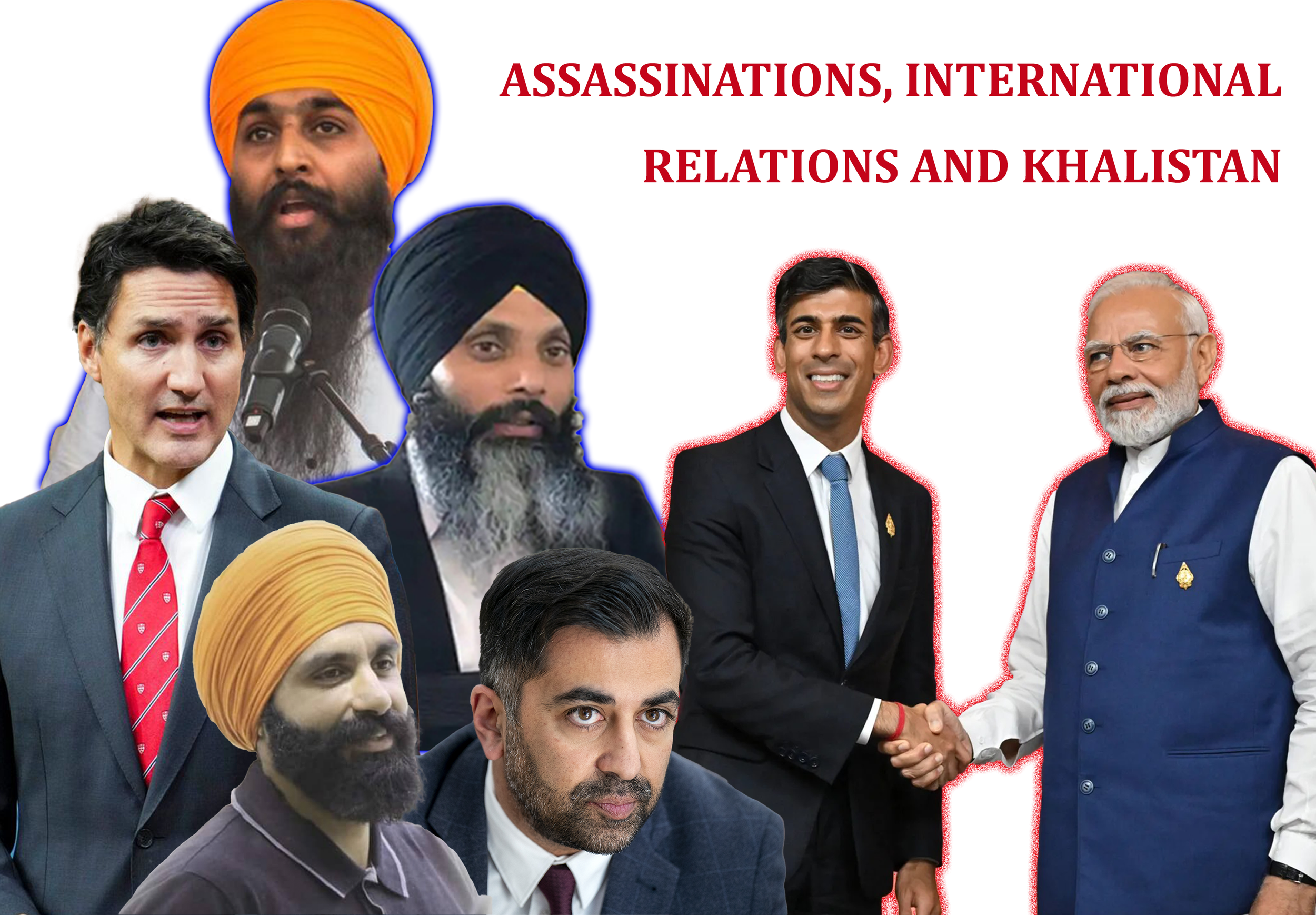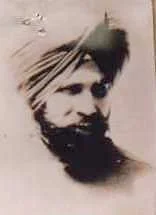Sant Jarnail Singh and the Kisaan
/“If the Hindu nation, having been enslaved for 900 years, can, after centuries, speak of self rule; for [only] 97 years the Sikh has been enslaved in Hindustan, why can we not speak of our sovereignty? Where is the prohibition for the Sikh? If rule was a bad thing, then Ranjit Singh had no need to rule. If rule was a bad thing then the creation of the Akal Takht, which sits in rivalry to the Harimandir sahib, would not be possible. If we could progress solely on religious grounds, then this couplet would not have been revealed, "From the truth spoken by the emancipator of the poor, sovereignty is found within [the power of] arms, without sovereignty there is no righteousness nor justice, without righteousness and justice all is lost and futile.”
- Bharpur Singh Balvir
Social media has been influential in getting the plight of Punjabi farmers, and those from other states in India, into the awareness of millions globally. Key among those are the Sikh diaspora who have been the most active in protesting and demonstrating against the bills in support of the Farmers. One of the major drawbacks of social media however is that in the same way that millions of random social media users can get involved to proliferate messages in support of the farmers, they can also so unknowingly be the carriers of subversive messages which have been planted to sabotage the movement. If this is then retweeted or shared hundreds of thousands of times it then becomes difficult to disassociate, or differentiate between what are our voices, and the messaging that has been planted.
One such message that has been doing the rounds recently is this idea and warning that the Farmers protest and the movement for Khalistan should be kept separate, that slogans for Khalistan or messages about Khalistan should not be raised when speaking about the farmer protest, and that doing so is “hijacking of the farmer protest” or worse, is detrimental to the Farmers Protest.
On the surface to the naive or uninformed, this message may appear harmless, perhaps even helpful, so much so that even ardent Khalistan supporters have bought into it and have either been censoring themselves or others. This message, to separate Khalistan, was originated in India by government sponsored media platforms including television and print media to demonise the Khalistan movement, and coerce farmers who were raising Khalistan within the debate and pushing the conversation towards Punjab’s autonomy as the only lasting solution, to stop.
India continues to criminalise dissent and silence anyone who speaks in favour of Khalistan, in the knowledge that although the armed movement for Khalistan has slowed down since the 90s, the ground remains primed and fertile. For Sikhs sovereignty is intrinsic to their being and therefore inherent in all forms of their socio-political struggle as evidenced from the powerful Sikhi-centric expression clearly visible in the recent uprisings.
The Khalistan Sangarsh and the farmer protest cannot be separated; The Khalistan struggle aims to liberate Sikhs and the same land that these Indian laws aim to enslave. The Khalistan and Kisaan movements are both motivated and influenced by Sikh Patshahi which is defined through opposition to any/all forms of exploitation. The key difference is that the Khalistan movement has more powerfully and explicitly centred Sikhi and thus has built a more enduring and powerful political program/movement.
We are slaves both economically and politically … We are not the master of our destiny in any sphere. Over the past 44 years, we had been feeling at every step that our reins are in the hands of those who are blind themselves.
Babbar Khalsa (1991)
The Panthic Committee of Panj Singhs declared the formation of Khalistan on 29 April 1986, pronounced the ‘social structure of Khalistan’ with its main objective as Sarbat da Bhala, ie ‘welfare of humanity and service to society’. The Panthic Committee made it clear from the outset that the land and people of Panjab would no longer be broken on the wheel of Ashoka to service India and its capitalists:
‘The Khalistan government would like to distribute the natural boons and meet the bare minimum needs on humane basis. Monopolist and capitalist tendencies will not be allowed to influence the government machinery and peoples’ thinking’
Panthic Committee (1986)
This is why Sant Jarnail Singh Ji Bhindranwale (Sant Ji), an icon for the Khalistan Sangarsh, is evoked as a rallying figure for the farmers. To the dismay of the Indian media, Sant Ji features in speeches of activists and artists on the ground such as Kanwar Grewal and Deep Sidhu, his immortal words are quoted in massively popular folk songs in support of the Kisaans, and his image adorns the many trucks and vehicles that have descended on Delhi from Panjab, in one incident even a truck contracted to carry barriers for the Delhi police had a large photograph of Sant Ji on its windscreen.
Sant Ji’s message of liberation, martyrdom over slavery, and uniting under the Kesari nishaan Sahib, is as true today as it has ever been.
The reason that Panjabi Kisaans hold Sant Ji in such esteem, is that he is one of them - a farmer who inspired and blessed by the Guru challenged Delhi, when Sant Ji is evoked by Punjabi Kisaan, he is invoked as a representative of their fighting Sikhi spirit. Sant Ji is fondly remembered as being a modest farmer who would manually harvest his crops from the early hours of the morning until evening reciting Gurbani, who then became the formidable warrior saint who inspired an insurrection against the Centre. It is this connection and latent potential that Delhi fears most.
The Anandpur Sahib Resolution (ASR) that Sant Ji championed, sought to wrestle control from the Brahmin elite in the Central Government, in favour of greater autonomy for individual states within India. Implementation of the resolution would have resulted in the federal republic that had been envisioned and promised by Indian elites, and fought and died for mostly by poor Sikhs. The demands of the ASR addressed problems that still plague Punjab till this day, including:
fixing minimum wages in the rural sector
transferring authority over agricultural price controls from the Centre to the various State governments
diversification of agriculture and industrialization to create alternative livelihoods
Had the ASR been accepted by the Central Government at that time, there would be no farmer protests today.
It is widely known that the Dharam Yudh Morcha which Sant Ji spearheaded concluded in the Battle of Amritsar in June 1984, when the Central Government refused to accept demands including those contained in the ASR. What is lesser known is that the last stage of the Amritsar Morcha which provoked the hurried attack, was the call made to withhold grain shipments from Panjab to India. This was not an empty threat by any means, as a result of the momentum created by Sant Ji, with his fearless and incorruptible leadership, there was a huge boost in Sikh activism across all fronts. The Dharam Yudh Morcha attracted hundreds of thousands of volunteers and the Kisaan unions in Panjab, united with the Dharam Yudh Morcha, and saw a massive increase in their own activism. For their first time in decades there was an honest and courageous Sikh as the stalwart, who was beyond compromise.
Indira Gandhi’s government responded to the growing unrest in Panjab and massive civil rights movement against the State by deploying over 100,000s heavily armed troops into Panjab, sealing the border and launching an attack on Sri Darbar Sahib. Indira sought to crush the Sikh spirit, to break their backs, force them into submission. The invasion was as monumental failure, Sant Ji led the heroic defence which rallied millions of Sikhs worldwide in support of the struggle for Khalistan.
“If the discourse of sovereignty does not exist within the mind of the Sikh; then, within the cage of Hindustan, the children of our future will die like caged birds. The Sikh nation must understand this." - Bharpur Singh Balvir
While India’s policies affect all within India, the backbone of the farmers movement are the Sikhs from Panjab. There are many reasons for this, which all point to the same reality, everyone else in India has resigned themselves to the idea that they are Indian, and India can be reformed. Sikhs however, rejected the project of India from the outset. Sikh representatives such as Sardar Hukum Singh, were “frustrated and disappointed” with how the new rulers were reneging on pre-partition promises of a federal India, with a semi-autonomous Panjab, and recording an “emphatic protest” to the constitution as enabling “the development of administration into a fascist state”, refused to sign it.
To struggle for one's rights may be political activity for others, which they can choose to engage with or not, but for Sikhs this is intrinsic to our Panth (path/way). Activist Deep Sidhu articulated this beautifully when anti-Sikh elements complained that the Kisaan Morcha was being “coloured with religion”. They objected to the Nihang encampments, the hoisting of Nishaan Sahibs and other integral Sikh practices such as Ardas and Dhadhi. In response, Deep Sidhu pushed back at these disruptive attempts, arguing “we aren't bringing religion into the struggle, to struggle is our religion”.
It must be remembered that despite obscene inhumane oppression, the Khalistan movement continues to enjoy overwhelming popular support. In 1986 in a Sarbat Khalsa attended by half a million Sikhs, the Sikh Panth collectively decided that it was going to struggle for Khalistan. In 1989 in the Punjab political elections the entire state comprising of almost 25 million people, overwhelmingly voted in favour of candidates who were publicly aligned with the armed movement for Khalistan including the relatives of Sikh fighters and martyrs such as Bibi Bimal Kaur. In the 1991 elections the people again overwhelmingly sided with Khalistan. As recent as 2015 in a Sarbat Khalsa that was held, the Panth reaffirmed the decisions taken in 1986 and elected Bhai Jagtar Singh Hawara of the Babbar Khalsa as Jathedar of the Akaal Takhat.
The State’s attempt to coerce the Sikhs into hiding their support for Khalistan, is simply a weak and aged attempt to portray the movement, which hundreds of thousands of Sikhs actively participated in, and millions support, as a fringe movement.
“This struggle is not one of our making, (one started in our lifetime), this is the struggle Guru Nanak started, against Mughal Emperor Babar.... We will not rest until we build a unique home... For Khalistan, to reach our Nishaana, we will shed every drop of our blood”
Shaheed Bhai Jugraj Singh Toofan – Khalistan Liberation Force
The Kisaan Morcha must be seen in the wider context, within a succession of agitations and movements against the State, against repressive policies, aimed at weakening Panjab. The issues faced by Sikh farmers in Panjab are a symptom of the larger unresolved issue of Kudh Mukhtiyaari (self-rule). During the struggle for Khalistan, going through the ebbs and flows is inevitable, and we must stop the further degradation of Panjab and exploitation of the Panjabi farmer. We must also however resist the pressure to withdraw Khalistan from our struggle, especially as a prerequisite for engaging with the State.
The Indian Government is afraid that should the message and thinking of Halemi Raj spread it will lead to the disintegration of India, that inevitability is the spirit of the Khalistan Sangarsh powerfully spread throughout the Kisaan agitation - that autonomy would be the first demand, that a political program would be formulated that broke the power of the State and placed it at the feet of the Sangat, that Panjab would once again raise arms for their liberation.
We can all see a glimpse of the Halemi Raj of the Khalsa at the protest sites surrounding Delhi with education, healthcare, and other social welfare projects available for all organically sprouting up instantaneously, addressing the desperate needs the Indian State has been unwilling to fulfil for nearly a century. The only thing that needs to be removed is the State itself which is the true obstacle to the liberation of the people.
Even though the indian media try their utmost to demonise Khalistan, it is not vilification or an insult to be called a Khalistani. I have been studying armed movements and liberation struggles from when I came across the IRA case of McCann (European Court Human Rights) in my first year at University in 2005. Since then I have studied the Irish liberation struggle, the Tamil Elam liberation struggle, and for the better part of two decades, the Khalistan Sangarsh. The Singhs and Kaurs of the Khalistan Sangarsh are some of the bravest, and in my opinion most respect worthy freedom fighters of all. They flipped the concept of guerilla warfare on its head, without the mountains and jungles enjoyed by their counterparts around the world, the Sikhs of the Sangarsh lived amongst the people, a true testament to the connection between them and the people they fought for.
It is a huge disservice to the hundreds of thousands of Sikhs that fought, and continue to struggle for Khalistan for us to remove Khalistan from our minds and lips at the behest of the indian government. If you aren't informed or brave enough to stand with Khalistan don’t stop those that are.






